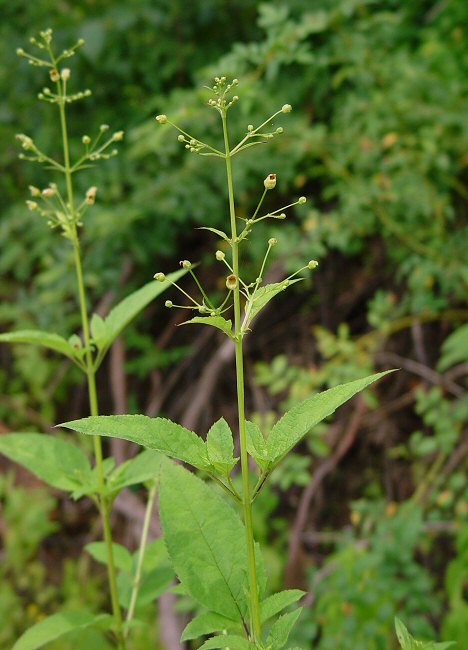Scrophularia marilandica L.
Eastern Figwort

Native
CC = 3
CW = 3
MOC = 64
© DETenaglia
Scrophularia marilandica L.Eastern Figwort | |
 |
Native CC = 3 CW = 3 MOC = 64 |
© DETenaglia |
|
Family - Scrophulariaceae Habit - Fibrous-rooted, perennial forb. Stems - Erect, to 1.7 m, usually simple, with 4 blunt angles and usually somewhat concave sides, or sometimes fluted with a single groove on each side of stem, moderately pubescent with minute, glandular hairs, at least toward the tip.
Leaves - Opposite, simple, petiolate. Petioles of the larger leaves 1.5-8.0 cm long, uniformly slender above the slightly expanded base, grooved and often paler on the upper side. Leaf blades 3-15 cm long, lanceolate to ovate, all but the uppermost leaves rounded to shallowly cordate at the base, bluntly to sharply toothed along the margins, the upper surface dull green and glabrous or sparsely and minutely glandular-hairy along the midvein, the undersurface paler, glabrous to moderately and minutely glandular-hairy.
Inflorescence - Terminal and axillary cylindrial to pyramididal panicles, mostly 5-18 cm wide, the main branches mostly spreading to loosely ascending. Inflorescence branches subtended by gradually smaller linear bracts. Peduncles and pedicels glandular-pubescent. Pedicels to 1.5 cm long in flower, slightly longer in fruit.
Flowers - Calyces 2.0-3.5 mm long. Corollas bilabiate, 5-9 mm long, yellowish green, glabrous, usually with reddish brown to brownish red mottling at least on the inner surface and along the margins, sometimes appearing nearly entirely reddish brown to brownish red. Staminode with the somewhat expanded tip dark purple to purplish brown, elliptic to ovate, longer than wide. Upper lip 2-lobed, the lobes rounded, reddish or at least with reddish margins. Lower lip 3-lobed, the lobes 2 mm long, rounded, the central lobe reflexed. Style exserted, greenish-white, often deflexed on the central lobe of the lower lip of the corolla, sparsely glandular pubescent or glabrous. Stamens 4, didynamous, one pair slightly exserted by the lower lip of the corolla. Filaments to 4 mm long, greenish-white, glandular-pubescent. Anthers yellow, 1.3 mm broad. Staminode purplish, adnate to the upper lip of the corolla, included. Ovary superior, green, ovoid, 1.2 mm long, 1.2 mm in diameter, subtended by a thick yellow nectariferous ring, 2-locular. Placentation axile. Ovules numerous.
Fruits - Capsules 4-7 mm long, the body broadly ovoid to nearly globose, broadly angled to broadly tapered at the tip, the surface often somewhat shiny at maturity. Seeds 0.6-0.9 mm long, oblong-ellipsoid, turgid, the surface with a network of ridges, dark brown.
Flowering - July - October. Habitat - Bottomland and mesic forests, streambanks, bottomland prairies. Origin - Native to the U.S. Lookalikes - S. lanceolata, which is rare in Missouri; vegetatively, Agastache nepetoides. Other info. - This species is found throughout Missouri, and also across most of the eastern half of the continental U.S. and Canada. When flowering, the plant is easily identified by its small, tubular, 2-lipped flowers which normally have a reddish blush on the inside. Differentiation from S. lanceolata can be difficult; however, this latter species is rare in Missouri. When not flowering, the plant is easily confused with Agastache nepetoides. One clue is that crushed vegetation of S. marilandica tends to have an unpleasant smell which is lacking in Agastache. There is also a tendency for stems of Agastache to be very sharp on two of the four edges, but this feature is not entirely reliable for differentiation. Photographs taken at Logan Creek, Reynolds County, MO., 7-13-03, and along the shores of the Current River, Carter County, MO., 7-9-04 (DETenaglia); also at Matson Hill County Park, St. Charles County, MO, 8-18-2015, Danville Conservation Area, Montgomery County, MO, 8-21-2015, Little Lost Creek Conservation Area, Warren County, MO, 10-9-2020, Castlewood State Park, St. Louis County, MO, 10-8-2021, and along the Katy Trail near Dutzow, Warren County, MO, 7-29-2022, (SRTurner). |